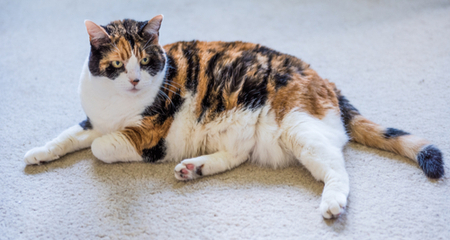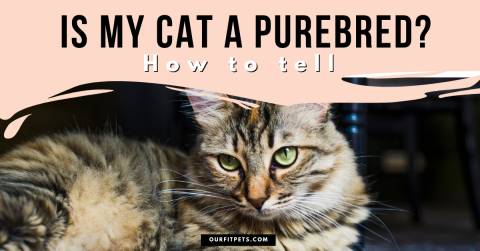You’re probably familiar with famous orange cats such as Garfield and Morris. These two famous ginger cats are well known for their unique personalities, beautiful coloring and being somewhat mischievous characters. However, what are the real facts about orange tabby cats?
Connect with a verified veterinarian in minutes. Licensed vets are available 24/7 to answer your questions. No need to worry about your furry family member.
In this article, we’ll take a look at some orange tabby cat facts such as are they more aggressive, what are their personality traits and more. One thing we’d like to say right from the beginning is that all cats are unique, beautiful individuals. No matter their color, all cats are amazing and pretty!
Facts about Orange Tabby Cats
In the course of researching this article, we came across some amazing facts about orange tabby cats including:
1). Orange and other colors: while many of us tend to call these beautiful cats “orange,” they also come in other various shades of orange, red and yellow including:
- Orange
- Ginger (yellow orange)
- Butter (mellow yellow)
- Marmalade (often used by the British)
- Red
- Butterscotch
- Caramel
You may sometimes hear people refer to these orange kitties as any one of the colors above, depending on the cat’s coloring. Orange cats also have distinctive markings such as black eyeliner (around their eyes), outlined pink nose, banding on tail, legs and body.
2). Orange tabby cats are not a breed: many people believe that orange cats are a separate, distinctive breed. Instead, orange kitties are actually all tabby cats. Again, “tabby” doesn’t refer to a breed, but rather to the coat pattern. The tabby coat pattern is seen across many cat breeds. No one is really sure where the term “tabby” comes from.
Some believe it comes from a type of silk that has stripes, called Atabi, which is made in Attabiah, Iraq. There are also some who say it comes from the French phrase for striped silk taffeta, which is “tabis.” It means watered silk. No matter where the name comes from, tabby cats are beautiful.
3). Are all orange cats tabbies: yes, all orange cats are tabbies; however, it’s important to note that not all tabby cats are orange. In fact, there are 5 different types of tabby coat patterns found across multiple cat breeds.
4). Why do orange tabby cats have the “M” on their foreheads: most tabby cats, including orange ones, have a distinctive “M” just above their eyes. This characteristic is seen across all types and colors of tabby cats. No one is certain why they carry the “M” above their eyes; however, some believe it has to do with improving their camouflage abilities. It could be this marking helped them in the wild.
5). Are all tabby cats male: no, they’re not. However, it is true that most ginger cats are usually male. The reason comes down to the cat’s genetic heritage. Coat color is determined by genes; in fact, the orange coat color is found on the X chromosome. Males carry one X and one Y, while females carry to X’s. A lady orange cat must have two orange genes (one from both parents). Male cats, on the other hand, only need one X and this comes from his mother. As a result, male orange tabbies tend to outnumber female orange tabbies by 4 to 1!
6). Orange tabbies talk a lot: this is true! According to National Geographic, orange tabby cats do tend to be more vocal than other cats.
7). Orange cats are often the last to be adopted: this is a sad fact, next to black cats, orange kitties are the next last to be adopted. This is a sad fact, even though these red lovelies make great fur babies when adopted.
8). Velcro kitties: orange tabbies are often referred to as “Velcro kitties.” That’s because they love to be with their pet parents, snuggle, and offer their affection.
9). Various coat patterns: like other tabbies, orange tabby cats have five distinctive coat patterns, including classic, mackerel, spotted, patched, and ticked.
10). They have freckles: when orange tabbies turn 2 years of age, they develop black spots on their noses and mouths. This is caused by a condition called lentigo. Lentigo is a genetic condition that causes the number of pigment cells to increase. The freckles are also found in tortoiseshells and calicos. The commonality is the ginger (red) gene in these kitties! Thankfully, the spots are nothing to worry about, though they may resemble skin conditions or other issues. If you’re worried about them, be sure to have your kitty’s freckles checked by the vet.
11). Females are more aggressive: female orange tabbies are sometimes said to be a little more aggressive than their male relations. They can be more aggressive and grumpy toward people (or other pets) they don’t know. So, bear this in mind if you have a female orange tabby. Again, it’s all in the genes!
12). Being chill: while the female orange tabbies can sometimes be a little more aggressive, overall, orange tabbies are more chill than other domestic cat breeds. It’s thought (by pet parents) that these cats must have a “couch potato” gene! Well, that’s not very scientific; however, they do seem to enjoy being calm, quiet, and more snuggly than other cats!
13). They’re taller: another interesting fact about orange tabbies is that they seem to be taller than other domestic cat breeds. Pet parents say their orange kitties are also a little wider. Scientists have not figured out if these factors are genetic or not. However, these kitties do seem to be a bit bigger. It could also be because orange tabbies are usually males, which are normally larger than females.
Orange Tabby Cat Personality
Why are orange tabby cats so affectionate? This is a common question you hear about orange tabbies. There’s a perception that ginger cats are somehow more affectionate than other types of cats. However, this is only a perception and hasn’t been verified by scientific testing. Another common question we hear is “Are orange cats more aggressive?” Again, this is a perception, rather than a truth when it comes to marmalade cats and their personalities. We’re not sure why people believe ginger cats are more aggressive. It could be due to their color; many people believe red and orange are indicative of aggression.
Truth be told, each cat is different and will have their own unique personality and temperament. Some orange tabby cats love to be held, while others are more standoffish. Or a butterscotch tabby cat may be grumpier, while another is quite happy and relaxed most of the time. It just depends on each individual ginger cat. Any cat’s personality comes down to the amount of socialization they’ve received with people, other cats and other animals. In fact, the prime time for socializing a cat is when they’re a kitten between the ages of three to nine weeks. During this time, a kitten must stay with their mom; however, this is the best time to acclimate a kitten to people and other animals.
The best way to socialize any kitten, including an orange tabby, is to use positive reinforcement. Another way to help kittens during the socialization process is to use treats (that are suitable for kittens). For instance, you can get your fur baby used to going in the pet carrier. Start off with your cute ginger fur baby spending a couple of minutes in the carrier, then give him a treat when he stays. Do this each day and add on another couple of minutes inside the carrier. Once he’s comfortable, then try to take her for a ride by putting him in the carrier and going for a short trip in the car. Each time offer him a treat.
Once your kitten has been socialized it will be necessary to keep socializing with him when he’s grown. Spend time playing, giving him attention, etc. This is key to keeping your orange tabby cat happy and enjoying time with you and other humans.

Review symptoms, medications & behavior to keep your pets healthy with a Vet Online in just minutes.
Ask a Vet Live NowWhy Are Orange Tabby Cats Lazy?
This is another misperception of our ginger feline friends. The famous ginger, Garfield, does tend to be lazy and fat. However, this is not necessarily true of all orange tabbies fur babies! Whether a cat is lazy or not depends completely upon their individual personality.
Just as there are some people who tend to be lazier than others, the same it true of our orange tabby friends. Some red cats will definitely be happiest when lounging around, waiting for their meals, and then lounging some more. They may not play as much, etc. However, a kitty can be just the opposite! You may find your orange tabby feline companion is full of energy and seems to be on the go day and night! Each kitty is unique and special in their own way.
Orange Tabby Cat Life Expectancy
Orange tabby cats have an average life expectancy of about 15 to 20 years. It’s important to remember that some cats will live longer than others. Factors that determine a cat’s life span include:
Genetics: this will depend on the genes your fur baby has received from his parents.
Diet & exercise: cats that have a nutritionally complete diet will avoid major health issues such as heart disease, obesity, arthritis, etc. And cats who also get plenty of exercise will avoid these and other health issues. With a better diet and a higher activity level, most cats will live 15-20 years or longer.
Living mainly indoors or outdoors: research has shown that indoor cats (or those that are mostly indoor) tend to live longer than outdoor cats. There are several reasons for this. Outdoor cats face many dangers to their health and wellbeing every day. These include diseases, traffic, traps, attacks by dogs, weather extremes, and even being stolen.
In addition, a cat who sees that vet on a regular basis is also more apt to live longer. The reason is because regular checkups can help the vet spot health issues early. With early treatment, cats can either be cured or managed, depending on the health problem(s) they have. The vet will also make sure your orange tabby fur baby receives his vaccinations on time. While you can’t control your fur baby’s genetics, you do have control over his diet & exercise, where he lives and that he sees the vet for regular checkups. All of these things can help you ginger fur baby live a longer, happier life.
Orange Tabby Cat Price
The price of an orange tabby cat depends on various factors including where you get your fur baby. If you buy from a breeder, cats generally cost a lot more. However, if you choose to adopt your ginger feline fur baby from a shelter, the cost could be substantially lower. Shelters may charge adoptions fees from $0 to $200, depending on their location.
If you’re thinking about adopting an orange tabby cat, there are other costs you’ll need to keep in mind besides the breeder fee or the adoption fee. Other costs deal with a cat’s care. These include:
- Food/treats
- Vet fees (including emergency care—you need to count on an emergency happening sometime during your fur baby’s life).
- Food and water bowls
- Leash and harness (some pet parents like to walk their feline companions)
- Pet sitting/boarding fees
- Professional grooming (if you have a kitty that has long, thick fur)
As you can see, orange tabby cats are special and unique. Each one ginger cat has their own personality, and comes in a different variation of red, orange, or pale yellow/gold. Orange tabbies are special fur babies who need and deserve the love of a fur every family, just as all cats do!
If you’ve just become the new, proud pet parent to a ginger cat, we’d like to wish you both all the best!
Connect with a verified veterinarian in minutes. Licensed vets are available 24/7 to answer your questions. No need to worry about your furry family member.

Tom
Tom has always loved to write since he was little - he wanted to be either a writer or a veterinary doctor, but he ended up being a professional writer while most of his works are based on animals. He was born in San Francisco but later moved to Texas to continue his job as a writer. He graduated from the University of San Francisco where he studied biotechnology. He is happily married and a soon to be father!
Review symptoms, medications & behavior to keep your pets healthy with a Vet Online in just minutes.
Ask a Vet Live Now



